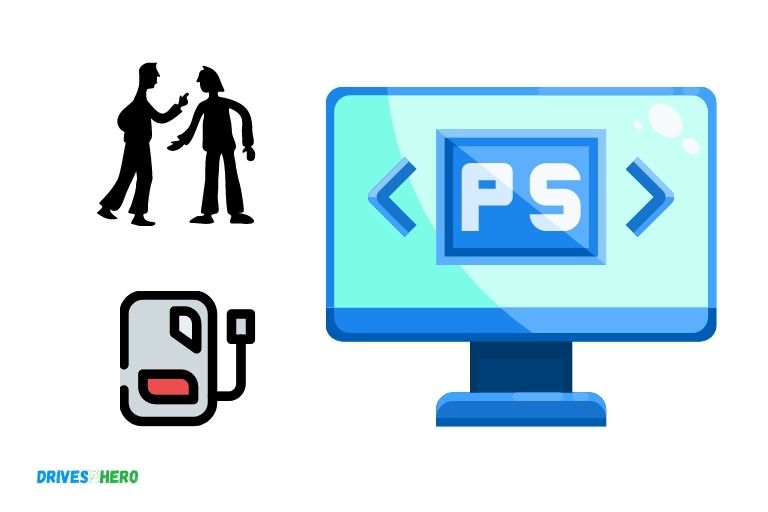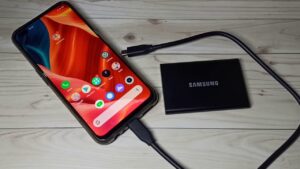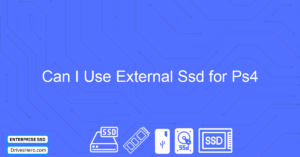How to Use External Ssd As Scratch Disk Photoshop? 10 Steps!
A Scratch disk in Photoshop is essentially a virtual workspace that Photoshop uses to perform its operations when the computer RAM is fully consumed.
When you set an external SSD as scratch disk, Photoshop will use it for temporary storage, which helps to increase your computer’s performance, particularly if you’re working on large files.
We’ll walk you through the simple steps to set up your external SSD, configure Photoshop preferences, and leverage the benefits of faster read and write speeds for enhanced editing efficiency.

Key Takeaway
Optimizing Photoshop Performance: Using an External SSD as a Scratch Disk
Step 1: Connect External SSD
Connect your external SSD to your computer using the appropriate cable or port.
Step 2: Format SSD
Ensure that the external SSD is formatted to a compatible file system such as exFAT or NTFS.
Step 3: Open Photoshop
Launch Adobe Photoshop on your computer.
Step 4: Access Preferences
Navigate to the “Edit” menu at the top of the Photoshop window, then select “Preferences,” and finally click on “Scratch Disks.”
Step 5: Choose External SSD
In the Scratch Disks preferences window, select your external SSD from the list of available drives.
Step 6: Set Priority
Arrange the order of the scratch disks by dragging your external SSD to the top of the list, indicating that Photoshop should prioritize it over other disks.
Step 7: Confirm Changes
Click “OK” to save your preferences and close the window.
Step 8: Restart Photoshop
Close and relaunch Photoshop to ensure that the changes take effect.
Step 9: Verify Usage
To confirm that Photoshop is using the external SSD as a scratch disk, monitor the scratch disk usage in the bottom left corner of the Photoshop window.
Step 10: Enjoy Improved Performance
Experience enhanced performance and responsiveness in Photoshop due to the faster read and write speeds of the external SSD.
By utilizing an external SSD as a scratch disk in Photoshop, users can significantly boost performance and efficiency. This straightforward process can lead to faster editing and smoother workflow, ultimately enhancing the overall creative experience.
Five Facts About Using External SSD as a Scratch Disk in Photoshop
Factors To Consider When Selecting An External Ssd
When selecting an external SSD for use as a scratch disk in Photoshop, it is important to consider factors such as storage capacity, speed, compatibility, and durability.
Capacity Requirements For Photoshop Projects:
- Evaluate the size and complexity of your typical Photoshop projects
- Consider the amount of storage space required for temporary files and cache
- Determine the maximum file size you may encounter and select a capacity accordingly
- Remember to leave some room for future projects and storage expansion
Read And Write Speeds:
- Look for an external SSD with high read and write speeds to minimize file transfer delays
- Faster speeds enable quicker access to data, resulting in faster operations within Photoshop
- Consider SSDs with sequential read/write speeds of at least 500MB/s for optimal performance
Importance Of Sustained Speeds For Photoshop Workflows:
- Sustained speeds refer to the ability of an SSD to maintain consistent performance over extended periods
- Photoshop work involves continuous read/write operations, making sustained speeds crucial for smooth operation
- Look for SSDs that maintain high performance even during intensive workloads to avoid potential bottlenecks
Interface Options (Usb 3.0, Thunderbolt, Etc.):
- USB 3.0 is a common and cost-effective option, providing sufficient speed for most users
- Thunderbolt offers even higher data transfer rates, reducing file transfer times significantly
- Consider your existing hardware and select an interface that is compatible and provides optimal speeds
Cost Considerations And Budget:
- Determine your budget and balance it with the performance requirements
- SSDs with larger capacities and faster speeds tend to be more expensive
- Compare prices and read reviews to find the best value for your specific needs
By considering these factors, you can select an external SSD that meets your Photoshop scratch disk requirements effectively.
Formatting And Partitioning The Ssd
Learn how to efficiently use an external SSD as a scratch disk for Adobe Photoshop by formatting and partitioning it properly. Maximize your performance and storage capabilities with these simple steps.
Formatting The Ssd For Compatibility With Both Windows And Mac:
When it comes to using an external SSD as a scratch disk for Photoshop, one important consideration is to format the SSD in a way that ensures compatibility with both Windows and Mac operating systems.
Here are some options to achieve this:
FAT32 format: One option is to format the SSD using the FAT32 file system. This format is compatible with both Windows and Mac, allowing you to seamlessly switch between the two operating systems.
However, FAT32 has some limitations, such as a maximum file size of 4GB and a maximum partition size of 2TB.
ExFAT format: Another viable choice is formatting the SSD using the ExFAT file system. ExFAT offers better compatibility compared to FAT32, as it supports larger file sizes and partition sizes. This format is suitable for working with large Photoshop files on both Windows and Mac.
NTFS format: If you primarily use Windows and occasionally work on Mac, formatting the SSD as NTFS might be a suitable option.
NTFS is the default file system for Windows and offers robust features and security. However, note that Mac can read from NTFS but cannot write to it without third-party software.
Partitioning The Ssd For Optimal Scratch Disk Performance:
To maximize the performance of your external SSD as a scratch disk for Photoshop, it is advisable to partition it appropriately.
Here are some considerations:
Single partition: One option is to create a single partition on the SSD to be utilized exclusively as a scratch disk. This approach ensures that the entire SSD storage is dedicated to Photoshop’s scratch space, maximizing performance.
Separate partition for scratch disk and other data: Another approach is to create separate partitions on the SSD, allocating a specific partition exclusively for the scratch disk and keeping other data on separate partitions.
This can help isolate Photoshop’s scratch data and prevent it from affecting other files and applications on the SSD.
Partition size: When partitioning the SSD, it is important to consider the size of each partition. Allocate sufficient space for the scratch disk partition, depending on your workflow and the size of the Photoshop files you typically work with.
By formatting the SSD for compatibility and partitioning it effectively, you can optimize its performance as a scratch disk for Photoshop.
Configuring Photoshop To Use The External Ssd
Learn how to configure Photoshop to use an external SSD as a scratch disk, improving performance and freeing up space on your computer.
Here’s how you can configure Photoshop to use the external SSD:
Accessing The Preferences Menu In Photoshop
- Launch Photoshop and open any project or create a new one.
- From the menu bar, navigate to the “Edit” menu.
- Click on “Preferences” and select “Performance” from the dropdown list.
- The Preferences dialog box will then appear, with the “Performance” tab selected.
Setting The External Ssd As The Primary Scratch Disk
- Within the “Performance” tab of the Preferences dialog box, you’ll find a section labeled “Scratch Disks.”
- Locate the external SSD in the list of available drives and ensure it is connected to your computer.
- Check the box next to the external SSD to designate it as the primary scratch disk.
- If desired, you can prioritize multiple scratch disks by rearranging them in the list. The topmost drive will be utilized first.
Adjusting Other Scratch Disk And Performance Settings In Photoshop
- In addition to setting the primary scratch disk, you can control other aspects of Photoshop’s performance.
- Lower down in the Preferences dialog box, you’ll find a section called “Memory Usage.”
- Here, you can allocate more RAM for Photoshop to utilize, which can further enhance performance.
- Move the slider towards the right to increase the RAM allocation.
- It’s important to strike a balance, as allocating too much RAM may slow down other applications running on your computer.
- Finally, click the “OK” button to save your changes and apply the new configuration.
By following these steps and configuring Photoshop to utilize your external SSD as the scratch disk, you can optimize the software’s performance and reduce the rendering time for your projects.
Managing Storage Space On The External Ssd
Learn how to effectively manage storage space on your external SSD and optimize its usage as a scratch disk for Photoshop.
Monitoring Available Space On The Ssd
One of the essential aspects of managing storage space on your external SSD is keeping a close eye on the available space.
Here’s how you can effectively monitor and stay informed about the storage status:
- Regularly check the available storage space of your external SSD by viewing the drive’s properties or using third-party software designed for this purpose.
- Set up automated notifications or alerts to receive updates on the storage capacity of your SSD. This can help you take action immediately if you approach the limits.
- Develop a habit of monitoring the available space before starting any significant project, ensuring you have ample storage to accommodate your creative needs.
Clearing Temporary Files And Cache Regularly
To optimize storage on your external SSD, it’s crucial to clear out temporary files and cache regularly. These files accumulate over time and can take up a significant amount of storage space if left unattended.
Here are some methods to efficiently manage temporary data in Photoshop:
- Within Photoshop, navigate to the Preferences menu and select the “Media & Disk Cache” option. Here, you can specify a location for the cache files and set the size limit. Regularly clear the cache or adjust the settings to prevent excessive space consumption.
- Periodically delete temporary and backup files created during your editing sessions. These files can be safely removed if they are no longer needed.
- Utilize automated solutions or scripts that can clear temporary files and cache on a scheduled basis, giving you peace of mind and consistently freeing up storage space.
By actively monitoring and managing your external SSD’s storage space, you can ensure a seamless and efficient workflow on Photoshop.
With these tips, you can make the most out of your storage capacity and avoid any potential bottlenecks that might hamper your creative process.
Addressing Slow Performance Or Lag In Photoshop
Experience slow performance or lag while using Photoshop? Speed things up by utilizing an external SSD as a scratch disk. Boost your editing capabilities and enhance your workflow with this efficient solution.
Checking For Software Updates In Photoshop And Ssd Firmware:
Keeping your software up to date is vital to ensure optimal performance in Photoshop.
Here’s what you need to do:
- Open Photoshop and navigate to the Help menu.
- Select “Updates” to check for any available software updates.
- Install any updates found to take advantage of bug fixes and performance enhancements.
Similarly, keeping your external SSD firmware updated can improve its stability and compatibility with Photoshop:
- Visit the manufacturer’s website for your SSD to find the latest firmware releases.
- Follow their instructions to update the firmware, ensuring you have backups of your data beforehand.
Optimizing System Settings For Photoshop:
Tweaking your system settings can significantly improve Photoshop’s performance.
Consider the following:
- Use the recommended minimum system requirements to run Photoshop smoothly.
- Adjust the performance preferences within Photoshop to allocate more resources to enhance its performance.
- Optimize your scratch disk settings to utilize your external SSD as the primary scratch disk for Photoshop.
Troubleshooting Hardware Issues Or Connectivity Problems:
Unexpected hardware issues or connectivity problems can also impact Photoshop’s performance.
Check the connection between your external SSD and your computer:
Ensure the cable is securely connected. Try using a different cable or port to rule out any hardware issues.
- Test your external SSD on another computer to determine if the issue lies with your computer or the SSD itself.
- If problems persist, reach out to the manufacturer for further assistance or consider seeking professional help.
By following these steps and addressing any software, system, or hardware-related issues, you can resolve the slow performance or lag you may experience in Photoshop.
Remember, properly utilizing your external SSD as a scratch disk can also significantly improve Photoshop’s overall performance.
Resolving Compatibility Issues With Photoshop Or Other Software
Resolve compatibility issues with Photoshop or any other software by using an external SSD as a scratch disk.
This allows for smoother performance and faster processing, enhancing your editing experience. Optimize your workflow and maximize your productivity with this simple solution.
Updating Photoshop To The Latest Version
To begin, make sure you have the most recent version of Photoshop installed on your system. Updating the software can often address compatibility issues with external SSDs.
Here’s how you can do it:
- Open Photoshop.
- Go to the “Help” menu.
- Click on “Updates”.
- Follow the prompts to install any available updates.
- Once the update is complete, restart Photoshop and check if the compatibility issue persists.
Checking For Software Compatibility With The External Ssd
If updating Photoshop doesn’t resolve the issue, you should verify if your software is compatible with using an external SSD as a scratch disk. Some software may have specific requirements or limitations when it comes to storage devices.
Follow these steps to confirm compatibility:
- Visit the official website of the software you are using.
- Look for the system requirements or specifications section.
- Check if there are any specific mentions about using external SSDs as scratch disks.
- Ensure that the software is compatible with your particular external SSD model.
- If compatibility issues are mentioned, consider alternative solutions or reach out to the software vendor for further guidance.
Seeking Support From Adobe Or Other Software Vendors
If you’ve tried the above steps and are still facing compatibility issues, it’s time to seek support from Adobe or the relevant software vendors.
These companies have dedicated support teams that can assist you in resolving software-related problems.
Follow these steps to get the support you need:
- Visit the official website of the software vendor.
- Look for the support or contact section.
- Submit a support ticket or reach out via the provided contact methods.
- Explain the compatibility issue you are experiencing with the external SSD.
- Provide any relevant details, such as software version, external SSD model, and steps you have taken so far.
By following these steps, you can address compatibility issues with Photoshop or other software when using an external SSD as a scratch disk.
FAQ About How to Use External Ssd as Scratch Disk Photoshop
What is a Scratch Disk And What Does It Do?
A scratch disk is a secondary storage device used for temporarily storing data, usually when the main memory of the computer is full. It can be a hard drive, USB flash drive or optical disc.
The scratch disk allows programs to use more memory than what is physically available in the system’s RAM by swapping out less frequently used data from RAM and writing it to the scratch disk.
How Do I Configure My External Ssd As a Scratch Disk for Photoshop?
1. Connect your external SSD drive to the computer.
2. Open Photoshop and go to Preferences > Performance.
3. Under Scratch Disks, select the external SSD from the list of available drives and click OK.
4. Restart Photoshop for changes to take effect.
Is an External SSD Better Than an Internal Hard Drive for Use As a Scratch Disk in Photoshop?
Yes, an external SSD is better than an internal hard drive for use as a scratch disk in Photoshop.
An SSD provides faster read and write speeds than a traditional HDD, which helps to improve the performance of applications like Photoshop that require frequent access to large files.
Because external SSDs are removable, they can be easily taken on the go for editing tasks away from home or office.
Are There Any Special Considerations I Should Make When Using an External SSD As a Scratch Disk With Photoshop?
Yes, there are several special considerations to make when using an external SSD as a scratch disk with Photoshop.
Firstly, the read/write speed of the external drive must be fast enough to handle high-resolution images and rendering tasks.
Secondly, the connection between your computer and the SSD must be stable so that data transfers do not get interrupted.
Lastly, if you plan on storing large files or working with multiple layers in Photoshop on an external drive, make sure you have sufficient storage capacity available for those files.
Conclusion
Utilizing an external SSD as a scratch disk in Photoshop can significantly enhance your editing experience.
The increased storage and faster read/write speeds of an SSD allow for smoother and more efficient performance when working with large and complex files.
By offloading the temporary data to the external SSD, you can free up your computer’s internal storage, preventing it from being overwhelmed and slowing down.
The portability of external SSDs enables you to transfer your work seamlessly between different devices without compromising performance.






